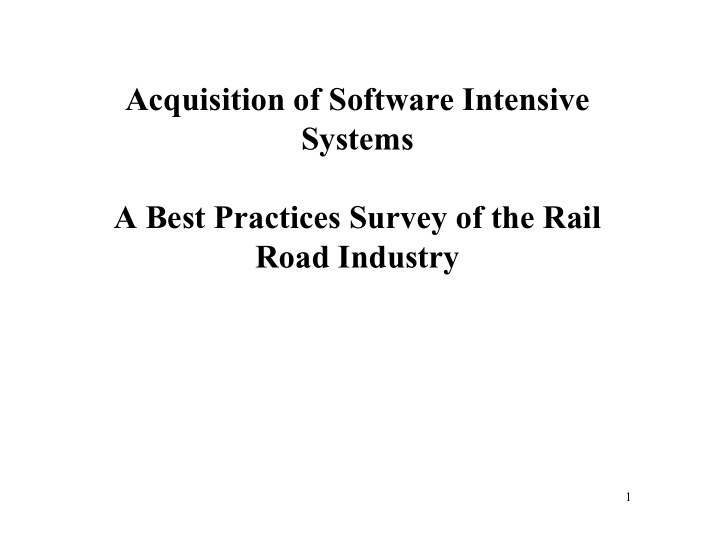



Acquisition of Software Intensive Systems A Best Practices Survey of the Rail Road Industry 1
Purpose To survey the U.S. Rail Road industry to benchmark best practices in acquisition of software intensive systems. 2
Survey Results l 47 Surveys were sent to Commuter, Light Rail, Heavy Rail, and Freight Rail Roads in mid-August 2003. l 11 Agencies/Organizations participated (Bart, Metra, CTA, MBTA, MNCR, NJT, NYCTA, SEPTA, LIRR, WMATA, UP). l 15 were returned and tabulated. l Surveys were sent to Project Managers, Engineers, Engineering Managers appropriate for their respective organization. 3
Background Information l Current job title? Manager (5), Director (3), Asst V.P. (1) l Years of Rail Road experience? Average of 21 years. l Type of Rail Road? Commuter Rail (9), Heavy Rail Transit (3), Light Rail (2), Freight (1). l Years of S/W experience? Average of 17 years. l When was your last S/W purchase? 80% within 3 years. l What type of system? RR Cars ( 5 ), Car subsystem ( 3 ), Train control ( 4 ), Other( 3). 4
Project Management l Do you have PM procedures? 93% Yes l Are Project Management Plans developed? 80% Yes l Are Quality Plans Developed? 93% Yes l Who leads your S/W projects? – Project Manager: 80% – Engineer: 13% – Consultant: 7% l Contract deliverables = Milestone payments? 100% Yes l Did your projects include multiple systems? 93% Yes l Project quality oversight was provided by? Average of 5.8 5
Specification l How much time for spec’ development? 9 months (avg) l Specification developed in-house or outside? – 80% said “both” – 20% internal l Was the programming language specified? l 78% said it was left up to the developer. l 22% was specified. l S/W development standards specified? 80% Yes l Which ones? IEEE 730, 830, 1016, CMM, ATA A652 & 102, MIL std 498, ISO. l Did your spec’ contain a specific section for S/W? 6
Specification cont’d Attributes Included in the Specification IEEE software standards – 80% Capability Maturity Models – 27% Configuration Management – 80% S/W Development life cycle – 13% Escrow requirements – 60% S/W Maintenance – 33% S/W Quality Assurance Plans – 73% S/W Testing requirements – 67% Bug tracking – 13% 30/60/90/100 Design reviews – 60% Verification/Validation Plans – 73% Change Review Boards – 27% Failure Review Boards – 13% Requirements Management – 27% 7
Design l How much time for design? 14 months (avg) l What type of design documentation? IEEE 1016, SRS, SDD, SFD, SVVP, S/W Fault Tree Analysis, MIL std 498, ATA 102, Flow Charts, Block Diagrams. l What type of design reviews? CDR, PDR, FDR, Functional, S/W Req’ Review, 30-60-90-final. l Design phases = milestone payments? 100% Yes l S/W architecture required? 57% l S/W design walk-throughs done? 73% l Formal reviews done after each design phase? 87% Yes l Requirements for coding/programming notes included? 80% Yes 8
Verification , Validation, Qualification & Test l Was IEEE 1012 specified? 36% Yes l Did your company witness V & V activities? 87% Yes l Formal test plans required? – Reviewed & approved? 100% – Prior to testing? 86% l S/W qualification tests required prior to FAI? 36% Yes l Regression testing performed? 58% Yes 9
Software Quality Assurance l Do you perform QA audits of your S/W developers? 73% Yes l Do you require developer’s S/W QA plans? 87% Yes l Do you specify IEEE 730 for the developer’s SQA plans? 67% Yes – If not are they based on any standard? ISO, MILstd 498 l Perform documentation reviews using standard checklists? 73% Yes l Do you have First Article Inspections procedures? 57% Yes 10
Configuration Management l Were CM requirements included in the spec’? 87% Yes l Was it based on IEEE 828? 17% Yes l Do you have internal CM processes? 75% Yes l Are all S/W mods/changes approved: – Prior to testing? 80% Yes – Prior to installation? 100% Yes 11
Escrow l Are escrow requirements included in your spec? 60% Yes If Yes ……. l Are development environment components included? 78% Yes l Do you allow your S/W developers to escrow their own S/W? 56% Yes If No …… l Submittal of S/W code at the end of the project? 86% Yes 12
Capability Maturity Models l Do you require S/W development CMM requirements in your specification? 20% Yes l Has your company adopted the S/W acquisition CMM into its own business practices? 13% Yes 13
Maintenance l Were there any oversight activities performed during the maintenance phase? 67% Yes l Causes of maintenance: – Polishing (minor bugs)? 100 % Yes – Repairing (major bugs)? 100 % Yes – Enhancements? 80% yes l Did changes go through the same review as original developments? 80% Yes l Was that a project requirement? 80% Yes – An established developer procedure? – Both? 85% Yes 14
What were the most successful tools used? l Extensive on-site testing. l Knowledgeable individuals. l Piloting l Periodic reviews. l “Requisite Pro”. l “Labview”. l IEEE standards. l SCMP, SRS, SDD l MS Visual SourceSafe 15
What areas need improvement? l Improved S/W estimates. l Bug tracking. l Test plans. l Configuration Management. (2) l S/W documentation. l Availability of source code. l More development time. l Optimization during warranty. l Software architecture. l Documentation of embedded S/W on EPROMS. l Enforcement of contract. l Better understanding of diagnostic S/W. 16
Do you have a formal lessons learned program? l 40 % Yes 17
Questions/Comments Contact information: Andrew Frohn Deputy General Manager Long Island Rail Road Jamaica, NY 11435 Office:718-558-4548 Mobile:516-315-8786 Email: afrohn@lirr.org 18
Recommend
More recommend